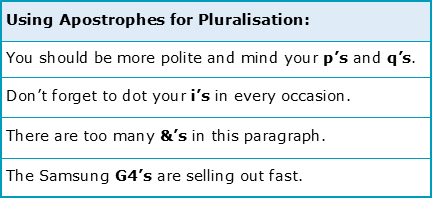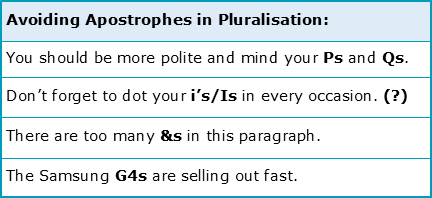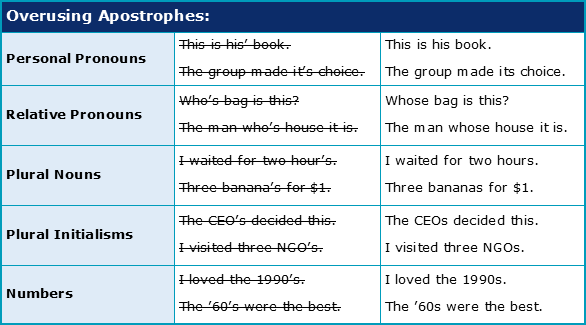Which apostrophe errors are most common?

This is the fourth and final chapter about Apostrophes. To complete this reader, read each chapter carefully and then unlock and complete our materials to check your understanding.
– Explore the concept of pluralisation with apostrophes
– Introduce four common mistakes that students make when using this punctuation mark
– Provide examples to help guide the reader
Before you begin reading...
-
video and audio texts
-
knowledge checks and quizzes
-
skills practices, tasks and assignments
Chapter 4
While Chapter 1 covered the basics, and Chapters 2 and 3 provided rules for demonstrating omission and possession respectively, this fourth and final chapter about apostrophes (’) next focuses on informing students about how to avoid some of the most common errors when using this punctuation mark. By learning, understanding and remembering these four chapters and applying this information to their writing, editing and proofreading, students should hopefully submit more successful academic assignments each time.
Mistake 1: Pluralising with Apostrophes
One common mistake made by both native and non-native speakers of English is the use of an apostrophe to indicate the plural of a noun, such as ‘three banana’s for $1’ instead of the correct ‘three bananas for $1’. Because this mistake is reportedly so common among those who sell fresh produce, this error has been called ‘the greengrocer’s apostrophe’ and should be avoided by students of academic English.
However, as was outlined in Chapter 1, one additional and contentious function of the apostrophe is that it can be used to demonstrate pluralisation in certain circumstances. The only scenario in which it may be acceptable to use an apostrophe in this way is when attempting to provide the plural of individual lower-case letters (such as ‘p’) and symbols (such as ‘&’), as is exemplified in the following table:

However, as can be seen in the next table in which the apostrophes have either been removed altogether or the lower-case letters have been capitalised, it’s most often unnecessary to use apostrophes in this way. Academic Marker therefore recommends that students should avoid using apostrophes to demonstrate plurality in all instances, unless absolutely necessary for clarity (as may be the case for ‘i’):

Mistake 2: Overusing Apostrophes
Much like the greengrocer’s apostrophe which is considerably overused when pluralising, many speakers of English also tend to overuse apostrophes in a number of other ways. As the following table highlights, errors when using this punctuation mark are particularly common among personal pronouns (such as ‘its’), relative pronouns (such as ‘whose’), plural nouns (such as ‘bananas’), and when writing the plural of initialisms and numbers:

Mistake 3: Using Apostrophes with other Punctuation
Though less common, the third mistake on this list occurs when attempting to use the apostrophe in conjunction with other punctuation marks, such as full stops or quotation marks. To avoid making mistakes in this area, the following three rules should help you:
(1) Apostrophes should always point to the top right (’) and never to the top left (‘).
(2) Apostrophes should never be separated from the word they’ve been attached to (to show omission or possession) by any other punctuation mark, unless;
(3) If the word already has a punctuation mark in it’s form, such as ‘U.S.A.’, then the apostrophe and the suffix ‘-s’ should be added in the usual way: ‘U.S.A.’s’.
Mistake 4: Recognising Non-English Apostrophes
Finally, it’s important that students are able to understand that the apostrophe may be used in different ways in different languages, and to recognise when a particular word is not of English origin. Scottish and Irish names, for example, may be written with an apostrophe as ‘O’Grady’ or ‘M’Gregor’, German never uses an apostrophe to demonstrate possession, and Spanish rarely uses this punctuation mark anymore to show omission. Some languages even, such as Hawaiian, use the apostrophe in the same way as they do any other letter of the alphabet: to indicate a unique sound. What this means is that students should be careful of loanwords that have entered the English language as such words may not follow the rules outlined in this short reader. Ultimately, if you wish to write a word that uses apostrophes in an unusual way, and this word is not English in etymology, try to make sure that you maintain the original spelling and punctuation exactly as you found it.
Well done on completing our short reader on apostrophes. Consider studying another topic about sentence punctuation to increase your knowledge, and don’t forget to then unlock our supplementary materials to check your understanding.
Downloadables
Once you’ve completed all four chapters about apostrophes, you might also wish to download our beginner, intermediate and advanced worksheets to test your progress or print for your students. These professional PDF worksheets can be easily accessed for only a few Academic Marks.
Collect Academic Marks
-
100 Marks for joining
-
25 Marks for daily e-learning
-
100-200 for feedback/testimonials
-
100-500 for referring your colleages/friends